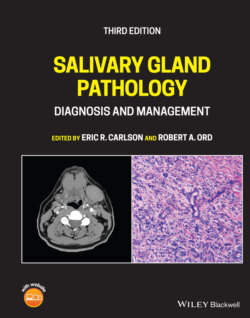Читать книгу Salivary Gland Pathology - Группа авторов - Страница 72
Other magnetic resonance imaging techniques
ОглавлениеAttempts have been made to develop MR sialography to replace the invasive technique of digital subtraction sialography. The techniques are based on acquiring heavily T2 weighted images to depict the ducts and branches. The lower spatial resolution and other technical factors have not allowed MR sialography to become a standard of care. This may change with newer single‐shot MR sequences and higher field strength magnets (Kalinowski et al. 2002; Shah et al. 2003; Takagi et al. 2005b). Dynamic MR sialography has also been used to assess function of parotid and submandibular glands at rest and under stimulation (Tanaka et al. 2007).
An extension of this concept is MR virtual endoscopy. MR virtual endoscopy can provide high‐resolution images of the lumen of salivary ducts comparable to sialendoscopy (Su et al. 2006). Although this initial experience was a preoperative assessment of the technology, it appears to be a promising method of noninvasive assessment of the ducts. In a similar manner, MR microscopy is a high‐resolution imaging technique employing tiny coils enabling highly detailed images of the glands (Takagi et al. 2005a). This technique was used to demonstrate morphologic changes in Sjögren syndrome (SS).
Use of supraparamagnetic iron oxide particle MR contrast agents has been under investigation for several years. The particles used for evaluation of lymph nodes are 20 nm or smaller. These are intravenously injected and are taken up by the cells in the reticuloendothelial system (RES). Since normal lymph nodes have a RES that is intact, they readily take up the iron oxide agents. MR imaging using T2 and T2* weighted images demonstrates susceptibility to the iron oxide and results in signal loss at sites of iron accumulation. Therefore, normal lymph nodes lose signal whereas metastatic lymph nodes whose RES has been replaced by metastases do not take up the particles and do not lose signal (Shah et al. 2003). Although not a direct imaging technique for the salivary glands, it may prove to be useful in the evaluation of nodal metastases.
